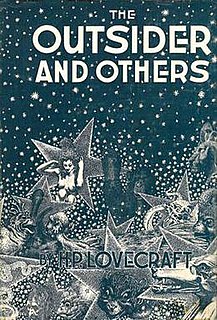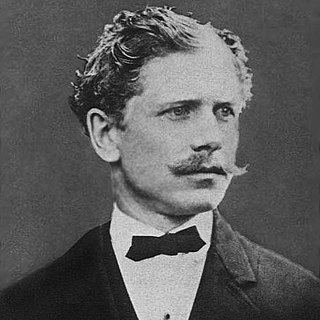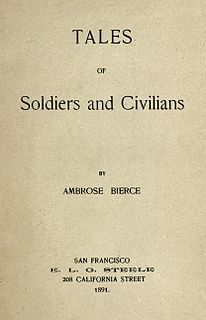
The Black Mass was a horror-fantasy radio drama produced by Erik Bauersfeld, a leading American radio dramatist of the post-television era. The series aired on KPFA (Berkeley) and KPFK from 1963 to 1967, on an irregular schedule. Bauersfeld was the Director of Drama and Literature at KPFA from 1966 to 1991.

The Devil's Dictionary is a satirical dictionary written by American Civil War soldier, journalist, and writer Ambrose Bierce consisting of common words followed by humorous and satirical definitions. The lexicon was written over three decades as a series of installments for magazines and newspapers. Bierce's witty definitions were imitated and plagiarized for years before he gathered them into books, first as The Cynic's Word Book in 1906 and then in a more complete version as The Devil's Dictionary in 1911.
"An Unfinished Race" is a short story by American Civil War soldier, wit, and writer Ambrose Bierce. The story, dealing with a mysterious disappearance of a man, was first published in The San Francisco Examiner on October 14, 1888 and was included in Bierce's collection Can Such Things Be? (1893). Bierce himself mysteriously disappeared in October 1914.

"An Occurrence at Owl Creek Bridge" (1890) is a short story by the American writer and Civil War veteran Ambrose Bierce. Described as "one of the most famous and frequently anthologized stories in American literature", it was originally published by The San Francisco Examiner on July 13, 1890, and was first collected in Bierce's book Tales of Soldiers and Civilians (1891). The story, which is set during the American Civil War, is known for its irregular time sequence and twist ending. Bierce's abandonment of strict linear narration in favor of the internal mind of the protagonist is an early example of the stream of consciousness narrative mode.
"A Horseman in the Sky" is a heavily anthologized short story by American Civil War soldier, wit, and writer Ambrose Bierce. It was published on April 14, 1889 under the title The Horseman in the Sky in the Sunday edition of The Examiner, a San Francisco newspaper owned by William Randolph Hearst. It is set during the American Civil War and is one of Bierce's best known war stories. Bierce revised the story for his book Tales of Soldiers and Civilians.

Ambrose Gwinnett Bierce was an American short story writer, journalist, poet, and Civil War veteran. His book The Devil's Dictionary was named as one of "The 100 Greatest Masterpieces of American Literature" by the American Revolution Bicentennial Administration. His story "An Occurrence at Owl Creek Bridge" has been described as "one of the most famous and frequently anthologized stories in American literature"; and his book Tales of Soldiers and Civilians was named by the Grolier Club as one of the 100 most influential American books printed before 1900.
"The Damned Thing" is a horror short story written by American Civil War soldier, wit, and writer Ambrose Bierce. It first appeared in Town Topics on December 7, 1893.

Tales of Soldiers and Civilians is a collection of short stories by American Civil War soldier, wit, and writer Ambrose Bierce, also published under the title In the Midst of Life. With a stated publication date of 1891 the stories describe unusual incidents in the lives of soldiers and civilians during the American Civil War. Tales of Soldiers and Civilians was named by the Grolier Club as one of the 100 most influential American books printed before 1900, stating "These short stories are among the finest, and best known, in American literature. ... Written in a clear simple style, with each phrase contributing to the total effect, Bierce's tales pointed the way for the American short-story writer." Bierce's famous story "An Occurrence at Owl Creek Bridge" is included in this collection.
"The Moonlit Road" is a gothic horror short story by American Civil War soldier, wit, and writer Ambrose Bierce. It first appeared in a 1907 issue of Cosmopolitan magazine, illustrated by Charles B. Falls. This story is presented in three parts and relates the tale of the murder of Julia Hetman from the perspective of her son, a man who may be her husband, and Julia herself, through a medium.
"Killed at Resaca" is a short story by American Civil War soldier, wit, and writer Ambrose Bierce. First published in The San Francisco Examiner on June 5, 1887, it was later included in Bierce's Tales of Soldiers and Civilians in 1891.
"The Man and the Snake" is a short story by American Civil War soldier, wit, and writer Ambrose Bierce. It tells of a man who dies of fright inspired by a toy snake with buttons for eyes. The story was published in The San Francisco Examiner on June 29, 1890.
"The Eyes of the Panther" is a short story by American Civil War soldier, wit, and writer Ambrose Bierce featuring a female werepanther. It was published in The San Francisco Examiner on 17 October, 1897 before appearing in his 1898 collection In the Midst of Life.
"Beyond the Wall" is a ghost story by American Civil War soldier, wit, and writer Ambrose Bierce. It was published by Cosmopolitan in December 1907.
"The Middle Toe of the Right Foot" is a ghost story by American Civil War soldier, wit, and writer Ambrose Bierce. It was first published in The San Francisco Examiner on April 17, 1890, and was reprinted the following year as part of Tales of Soldiers and Civilians.
"One of Twins" is a short story by American Civil War soldier, wit, and writer Ambrose Bierce exploring a telepathic connection between the twins. It was first published in The San Francisco Examiner on October 28, 1888 and was included in Bierce's 1893 collection of supernatural tales Can Such Things Be?

"The Death of Halpin Frayser" is a Gothic ghost story by Ambrose Bierce. It was first published in the San Francisco periodical The Wave on December 19, 1891 before appearing in the 1893 collection Can Such Things Be?
"One of the Missing" is a short story by American Civil War soldier, wit, and writer Ambrose Bierce. It was first published in The San Francisco Examiner on March 11, 1888 and was reprinted in Tales of Soldiers and Civilians (1891).
"A Tough Tussle" is a short story by American Civil War soldier, wit, and writer Ambrose Bierce. It was published on the first page of the Sunday supplement to The San Francisco Examiner on September 30, 1888 and was reprinted in Tales of Soldiers and Civilians (1891).
"The Secret of Macarger's Gulch" is a Gothic ghost story by American Civil War soldier, wit, and writer Ambrose Bierce. It was first published in the San Francisco periodical The Wave on April 25, 1891 before appearing in the 1893 collection Can Such Things Be?
Nightmare Classics is an American horror anthology television series created, produced and executive produced by Shelley Duvall featuring adaptations of well-known horror stories by authors including Henry James, Sheridan Le Fanu, Robert Louis Stevenson and Ambrose Bierce. Following the success of her two previous anthology series – Faerie Tale Theatre and Tall Tales & Legends – both of which were aimed at the elementary-school set, Duvall attempted to branch out to the teen and young adult audience with Nightmare Classics.





